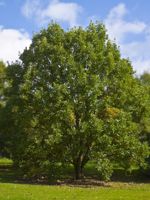Mon-Fri 9am - 5pm Mountain time
Black Locust vs Schuettes Oak
Robinia pseudoacacia
Quercus × schuettei (Quercus bicolor × Quercus macrocarpa)
NOT AVAILABLE THIS SEASON - MIGHT RETURN
Black Locust is an attractive tree. Its distinctive leaves are made of about a dozen bright green leaflets. It also notable for its fragrant white flowers, which smell of citrus.
Black Locust can grow in many situations, but prefers dry areas with lots of sun. It is robust and is an excellent choice for establishing shade in dry, open areas.
Important note: Much of the Black Locust is toxic to humans and livestock, including seeds, bark, and leaves.
Schuettes Oak is a naturally occurring hybrid of Swamp White Oak and Bur Oak. With a faster growth than both parent species, it is one of the fastest growing Oak trees. They are known for growing very large and wide, so space them appropriately. It is considered one of the most adaptable Oaks with little preference on soil conditions. It can handle growing in wet, saturated soils as well as those that are dry, clay, or alkaline.
The Schuettes Oak has very large acorns. They have a large cup portion like the Bur Oak, but without the fringe. Due to the Swamp White Oak parentage, the acorns have less tannins and a sweeter taste. They are a food source for various wildlife including birds, squirrels, and deer.
Black Locust Quick Facts
Schuettes Oak Quick Facts
Toxicity: when injested, can be toxic for many animals

